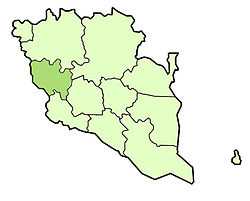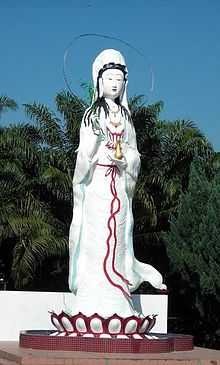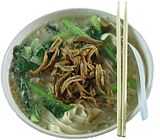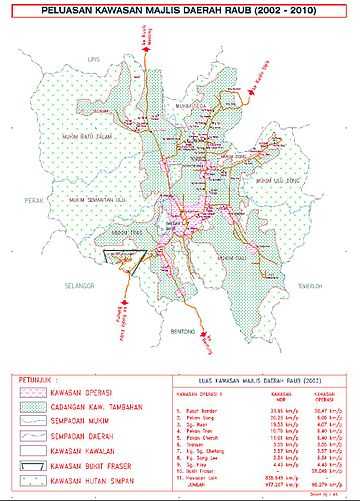Sungai Ruan
| Sungai Ruan 雙溪蘭 | |
|---|---|
| District of Malaysia | |
 | |
| Nickname(s): 'Town of Fruit' or 'SR Town' | |
 | |
| Coordinates: 3°47′N 101°52′E / 3.783°N 101.867°ECoordinates: 3°47′N 101°52′E / 3.783°N 101.867°E | |
| Country |
|
| State |
Darul Makmur |
| Establishment | Around 1948 |
| Seat | Raub |
| Government | |
| • Sultan | Sultan Ahmad Shah |
| • Menteri Besar |
Dato' Seri Haji Adnan bin Haji Yaakob |
| • District officer |
Dato' Sri Dr.Ng Yen Yen |
| Area | |
| • Total | 10 km2 (4 sq mi) |
| Population (2010) | |
| • Total | 10,000 |
| • Density | 1,000/km2 (2,600/sq mi) |
| Time zone | MST (UTC+8) |
| • Summer (DST) | Not observed (UTC) |
| District postal code | 27500 |
| District calling code |
09 (Pahang except as noted) 05 (Cameron Highlands) 03 (Genting Highlands) |
| Federated into FMS | 1895 |
| Japanese occupation | 1942 |
| Accession into Federation of Malaya | 1948 |
The destination of Sungai Ruan is located in the Negeri of Pahang in the country of Malaysia. The Arabic honorific of Pahang is Darul Makmur ("Abode of Tranquility"). Sungai Ruan, with a latitude of 3.8 (3° 47' 60 N) and a longitude of 101.87 (101° 52' 0 E), is a hydrographic (stream) located in the area / state of Pahang in Malaysia which are part of Asia.
The 10 square km area around Sungai Ruan has an approximate population of 10,000 (0.0001 persons per square meter) and an average elevation of 227 meters above the sea. The location is situated 1170 kilometers west (278°) of the approximate center of Malaysia and 73 kilometers north (15°) of the capital Kuala Lumpur.
Sungai Ruan one of the small and new village Raub district of Pahang, Malaysia which is surrounded by isolated forest and oil palm plantations. Sungai Ruan located about 13 km from Raub town. Most of the resident here are rubber tappers and farmers, a predominantly Chinese new village with plantations as their main source of income. The ethnic composition is roughly 15% Malay and Bumiputra, 65% Chinese, 5% Indians and 15% non-citizens.

| Ethnic groups in Sungai Ruan, 2011 census | ||
|---|---|---|
| Ethnicity | Percentage | |
| Chinese | 65.0% | |
| Malay & Bumiputra | 15.0% | |
| Indian | 5% | |
| Non-citizens | 15% | |
The majority of the community are farmers that own fruit orchards. This series shall be mainly of Malaysia fruits. During the durian peak season, workers were busy carrying rattan buckets full of durians especially the Musang King variety (the most popular variety for every year).
During the Chinese New Year, lion dancer troupes from the Chinese martial art schools or Chinese guild and associations will visit the houses and shops of the Chinese community to perform the traditional custom of "cai ching" (採青), literally means "plucking the greens", a quest by the 'lion' to pluck the auspicious green normally 'vegetables' like lettuce which in Chinese is called 'cái'(菜)that sound like 'cái'(财)(fortune) and auspicious fruit like oranges tied to a "Red Envelope" containing money; either hang highly or just put on a table in front of the premises.
The "lion" will dance and approach the "green" and "red evelope" like a curious cat, to "eat the green" and "spit" it out leave it in a nice arrangement, like an auspicious character but keep the "red envelope". The lion dance is believed to bring good luck and fortune to the business and the troupe is rewarded with the "red envelope".
History
1940
From 1940-87, Raub bastion is Malayan Communist Party (MCP) and include Lembah Klau. Sungai Ruan one of small town, is near Felda Lembah Klau. Communist choose mountain and big rock become their bastion, they choose in jungle of wilderness in Lembah Klau, at that time bastion of communist known by people. Malayan Communist Party (MCP) rejimen 10th consist from Sungai Ruan, Pahang.
Communist threat in 1940s in Raub results in erection of new settlements.
- (1948) Cheroh,
- (1948) Sang Lee,
- (1948) Sungai Ruan,
- (1948) Sungai Chetang,
- (1949) Bukit Koman,
- (1950) Sempalit,
- (1950) Sungai Lui,
- (1950) Tras,
- (1960) Sungai Klau.
1946 - 1951
From 1946-47, there are approximately 10 wooden house and a few of people. Due to the richest of soil that good for plantation, from 1951 a lot of resident from other village involve in this industry. Up until now there are more than thousand of families stay in Sungai Ruan.
1948 - 1970
Most of villager start to focus on education for their children. At 1948, villager build the primary school in Sungai Ruan centre area, at that time only 58 student study in primary school. Beside that, villager plan to build secondary school and preschool in 1965. Project complete on 1968 and name Sekolah Menengah Kebangsaan Sungai Ruan (SMKSR). Among 6 villages in Raub, Sungai Ruan is the only village that have secondary school. First of head teacher in secondary school is Mr.Leong Weeng Kee. In 1969 Grand opening of a secondary school. In same year, a lot of resident from other village involve in this industry and people grown up more that 3 - 5%. In 1960-70, Sungai Ruanstart to produce most famous durian, banana, guava and cocoa best selling in Malaysia. At that time Sungai Ruan become the village in pahang that produce the most fruits and people call Sungai Ruan become fruit of village.
1982 - 1989
In 1982, 4 person of communist was kill by soldier. Sungai Ruan was free in 1987 from Malayan Communist Party (MCP). After a series of negotiations between the Malaysian Government and the Malayan Communist Party (MCP), with the Thai Government as the mediator, the MCP finally agreed to sign a Peace Accord in Haadyai, Thailand on the 2 December 1989.
1990 - 1998
In 1990, Malaysia organize a campaign to beautify the residential area in village. With the teamwork, hardworking and sacrifice of resident in Sungai Ruan, they won the campaign of beautify in Malaysia as 2nd Runner Up in 1993 and 1st Runner Up in 1994. In 1996 to 1998, Hari Raya Puasa and Chinese New Year fell on the same week. There was a double celebration of the festivals within the Chinese and Muslim communities. The term 'Gongsi Raya' is a creolised term originating from Malaysia and accepted in Singapore to commemorate the two festivals. In the same years, villager have a big celebrate ceremony and fireworks together with Sultan.
2000s
In 2000s, Sungai Ruan produce peanuts, dragonfruit and coconut. Best selling in Sungai Ruan is peanut, during the Chinese New Year, villagers return home and brought a lot of the peanut for gift to friends and neighbor. In 2009 Malaysia government planning export of frozen durians to China. The projected export of frozen durians from Malaysia to China is between 350 tonnes and 500 tonnes a year. Malaysia exported fresh durians worth an estimated RM18.5mil to Singapore, against RM15.4mil in 2010.
Profile of Sungai Ruan

- For law enforcement, there are 1 police stations, with manpower of more than 50 policemen.
- For safety and fire problems, there are 1 fire stations with more than 20 personnel.
- For banking, there are 1 Agro Bank.
- 3 health clinics and rural clinics for health maintenance and disease prevention.
- 1 secondary school, 1 primary school, 2 preschool.
- 1 jail which is the 2nd biggest in pahang since the 1990s.
- 1 post office, 1 petrol station.
- 3 Chinese buddhist temple, 3 church building.
- 7 motorcycle service workshop, 2 bicycle service workshop and 3 car service workshop.
- 1 training center of hope academy.
- 1 cake shop in taman bunga raya.
Federal Parliament and State Assembly Seats
Raub district representative in the Federal Parliament (Dewan Rakyat)
| Parliament | Seat Name | Member of Parliament | Party |
|---|---|---|---|
| P80 | Raub | Dato' Sri Dr.Ng Yen Yen | BN |
Areas of Sungai Ruan
New Area
- Taman K.S.M
- Taman Sungai Ruan
- Taman Bunga Raya
- Taman Matahari
- Taman Dahlia
- Taman Mawar
- Taman Orckid
- Taman Bunga Matahari
Old Area
- Kawasan Barat 1
- Kawasan Barat 2
- Kawasan Timur 1
- Kawasan Timur 2
- Kawasan Tenggah 1
- Kawasan Tenggah 2
Food types
- ABC – ABC is abbreviation of 'Air Batu Campur' or known as Ice Kacang Sungai Ruan. It is a special desserts created from shaved ice added with corn, jelly, redbeans, groundnut, syrup, pasteurised milk, and liquid chocolate.
- Satay – is a popular food in Malaysia. Made from marinated meat or chicken and burnt on charcoal grill. Cooked satay is dipped in special peanut sauce.
- Char Kway Teow (Chinese : 炒粿條,炒河粉). Stir fried rice noodles with prawns, eggs (pork or chicken), chives and beansprouts. Usually, with an option of cockles as well.
- Wantan Noodle (Chinese : 雲吞麵), Chinese noodles with Chinese dumplings (Chinese : 雲吞), chooi sam and BBQ pork . Dumpling are usually made of Pork and/or prawns. The noodles may be served either in a bowl of soup with dumplings or on a plate with some dark soya sauce flavoured with oil and slices of roast pork and vegetable. For the latter, the dumplings will be served in a separate bowl with soup.
- Hokkien Mee(Chinese : 福建麵). A dish of thick yellow noodles fried in thick black soy sauce and pork lard which has been fried until it is crispy. This dish is served mostly in Kuala Lumpur, Seremban, Klang, Kuantan and Penang.
- Chicken Rice (Chinese : 雞飯). steamed chicken served with rice cooked in margarine or chicken fat & chicken stock and chicken soup.
- Bǎn miàn (刀麻切/手工板面), it is made using a hand-operated machine in the stall which forms noodles from the dough. The dish is served in soup, usually with pieces of minced chicken or minced pork, ikan bilis (anchovies), vegetables, and an egg, and also commonly comes with sliced mushrooms and fish balls.
- Doufuhua (豆腐花), is a Chinese dessert made with very soft tofu. It is also referred to as tofu pudding and soybean pudding.
| Food & Food types | Food & Food types |
|---|---|
| Beef noodle (牛腩面) | Dragonfruit |
| BBQ Chicken Wing | Rambutan |
| Satay | Mangosteen |
| Wantan Noodle | Musang King |
| Bǎn miàn (刀麻切/手工板面) | Banana |
| Hokkien mee | Cacao |
| RedBean Soup | Ciku |
| Chicken Rice | Ais Kacang (ABC) |
| Char Kway Teow | Coconut |
| Doufuhua (豆腐花) | Bubble tea (珍珠奶茶) |
Pictures Gallery
-

Durian season in Sungai Ruan
-

Lion Dancer in Temple Guan Yin
-

Main road in Sungai Ruan
-

BBQ Chicken wings famous in Sungai Ruan
-

Ais Kacang
-

Handmade Bǎn miàn (刀麻切/手工板面)
-

Sungai Ruan produce Peanut name Kacang Goreng Kulit Harimau Sungai Ruan
-

Police Car
-

S.R.J.K.(C) Sungai Ruan Assembly Hall
-

S.R.J.K.(C) Sungai Ruan
-

SMK Sungai Ruan
-

SMK Sungai Ruan
Geographic Location
 |
Kinta, |
Gua Musang, |
Hulu Terengganu / Dungun, |
 |
| Hulu Selangor, Batang Padang, |
|
South China Sea | ||
| ||||
| | ||||
| Hulu Langat / Gombak, |
Mersing / Segamat, Jempol / Jelebu, |
South China Sea |
Transportation
Transportation in Raub are unique. Everybody will share the same memory about the public transportation for Raubians. The main public transportation will be the Bus. The most common bus in Raub is Pahang Lin Siong, which travels everyday from Raub town to other places in Raub district, such as Tras, Sungai Chetang, Sang Lee, Sungai Ruan and other districts and places in Raub also.
The another famous bus are Union and Central which originally are separated entities. This few years, they have been merged into one company. Although they use the name of Union, most of the buses do still retain their name. These buses are the main transportation for going to other places, such as Kuala Lumpur, Kuantan and the furthest, Singapore as well.
Union and Central are very famous to Raubians. Most of the Raubian will remember the red Union and Central buses. Raub is also the terminal to Kota Bharu as well. Most of the buses will stop in Raub before continue their journey to Kuala Lipis, Gua Musang and other parts to the state of Kelantan. It serves as the alternative route to Kelantan, besides going through Kuantan and Terengganu.

List of junctions
| Km | Exit | Junctions | To | Remarks |
|---|---|---|---|---|
| KAMPUNG ASAP | NORTH SOUTH Kuala Lumpur Kuantan | T-junctions | ||
| Kampung Keruntong | ||||
| Kampung Lebu | ||||
| Kampung Hulu Lebu | ||||
| Jalan Sungai Ruan | NORTHEAST JALAN SUNGAI RUAN Sungai Ruan FELDA Klau 2 | T-junctions | ||
| FELDA Mempaga 1 | ||||
| Pusat Serenti Mempaga | ||||
| Jalan Lakum | EAST JALAN LAKUM FELDA Lakum Lanchang | T-junctions | ||
| Jalan Sertik | NORTH JALAN SERTIK FELDA Sertik | T-junctions | ||
| Kampung Cinta Manis | ||||
| Sungai Bentong bridge | ||||
| Karak-ECE | see also EXIT 813 KARAK INTERCHANGE | Interchange |
See also
External links
| |||||||||||||||||||||||
| ||||||||||